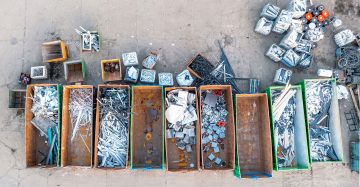

EPR and PRO
An introduction to EPR and PRO for a zero waste world
By John Dillon, VP Marketing Superfy, 31 January 2023

Creating a zero-waste world can feel near enough impossible – and in some cases, we have decades to go before we can truly undo the damage that we have caused the environment. There are some corners of the world where zero-waste is more attainable, for example in Sweden where they are the closest to a circular economy – having recovered over 90% of their waste!
To achieve zero wastage, there are a number of factors to consider: individual consumption, organisational consumption, the current economy of a location as well as how wealthy or poor an area is: all of these elements impact a zero-waste outcome.
We’re going to run through a brief introduction to EPR and PRO and how this can contribute to a zero-waste world.
What is EPR?
EPR stands for “Extended Producer Responsibility” and in essence, puts the onus of environmental costs throughout the product life cycle to the market price of that product. It uses a financial incentive to encourage manufacturers to design environmentally friendly products.
It can also encourage manufacturers to create their own recycling initiatives or reward consumers. For example, let’s say a zero-waste store creates its own jars of jam – but for 5 glass jars returned, a consumer receives 1 free jar of jam. This is a way to put the onus of the production cost into the product, whilst also encouraging a circular economic approach, and rewarding the consumer – either through monetary gain or extra product.
The concept of EPR was introduced in Sweden and is widely used by organisations, governments, and small businesses on a global scale. Fundamentally, it’s all about being responsible for all elements of your product – for its entire lifecycle.
“EPR is increasingly recognized worldwide as an efficient waste management policy to help improve recycling and reduce landfilling of products and materials. EPR programs, such as those implemented in the European Union, ensure that the producers, manufacturers, brand owners, and first importers of products and packaging are given the legal responsibility for collection, recycling, and end-of-life management of materials” – Sciencedirect
What are the elements you need for a successful EPR scheme?
To run a successful EPR scheme there are a few key elements to consider, we group this into three areas:
Tracking systems and relationship management
Your tracking systems enable you to take stock of your materials, its geolocation, supporting evidence, safety guidance, and calculations. In essence, your tracking systems will allow you to run a seamless process/scheme from start to finish. This, along with an adequate CRM (Customer Relationship Management) also allows you to manage members, customers, vendors, services, and in some cases financial status.
Data
Data is king! And, to run a successful EPR scheme, data is going to be your #1 superpower. Data can allow you to generate detailed and accurate location inventory, whilst also enabling you to analyse trends to make better decisions. Finally, data gives you the opportunity to optimise your process and make improvements: whether this is to make a process quicker or look at where you can save on cashflow, data is vital in the EPR process.
Process optimisation
And finally, the last element you need for a successful EPR scheme is process optimisation. If your data is in check, you can make time to regularly optimise processes such as material movement, integration, and container distribution and control:
Container distribution and control:
Data-driven control over locations and collection distribution of all containers.
Material movement:
Track vehicle loads and frequency data for planning and auditing purposes.
Integration:
Leverages complete APIs to facilitate a seamless and effective integration to your organisation backend environment.
What is PRO?
PRO stands for “Producer Responsibility Organisations” which are bodies that look to verify data, and ensure that there is compliance with legislative requirements directly relating to EPR. In essence, PRO and EPR are completely connected – and if PRO’s feel that an organisation isn’t accurately carrying out EPR – then they can report this to the relevant authorities.
There are a number of guides and frameworks online for organisations carrying out EPR – and the PRO’s are responsible for ensuring that corners aren’t being cut, and that organisations are also equipped with the right tools and information to ensure best practice.